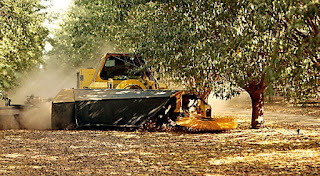But any farmer will tell you there’s little time to
rest after harvest. Cotton growers will vouch for that, citing state law
requiring them to plowdown their fields soon after the cotton is picked.
Field scout Damien Jelen says growers understand the
requirement and move quickly to plow under their fields well before the
December deadline set by local county agricultural commissioners.
“They
know the law and have been doing it (plowdown) for years,” Damien says,
pointing out almost all the cotton fields in the Northern San Joaquin Valley
have been plowed under. Only a couple of growers are still lagging.
 |
| Here's a picture of pink bollworm larvae. (UC IPM photo) |
It was 1967 when farm groups, UC farm advisers and
researchers, state, local and federal ag regulators launched a pink bollworm
eradication program in the San Joaquin Valley. The pink bollworm damages
squares and bolls. An overwintering population can affect next season’s crop.
Plowdown also prevents plant regrowth and reduces the build up of white flies.
Work starts after the cotton is harvested. Crews will
return to the field and uproot and shred the brown, dried cotton stalks. Then
they disc the field, plow down the debris about six inches deep, break up big
clods of dirt and then build new planting beds for next season.
“We
didn’t have too much rain this fall to force growers to pull the tractors from
the fields.” Damien said. As a result, growers were able to finish plowing down
their fields rather quickly.
 |
| Growers are good about plowing under the harvested fields. |
Each
fall, county agricultural commissioners will issue a deadline for all the
cotton fields to be plowed down. County ag officials are required by state law
to enforce plowdown rules and a host-free period through the early spring
(Growers can’t start planting until the host-free period ends).
State
ag officials point out the pink bollworm is the third pest ever in the history
of entomology to be fully eradicated. California cotton growers should take a
bow.










